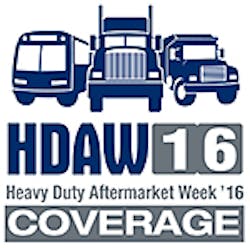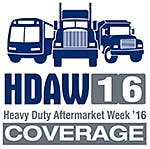ROYAL Jones’ first job out of high school was driving a truck in and around El Paso, Texas, in the mid-1970s.
He figured if he could get a second driver and find some efficiencies, he could double his money. Over a five-year period, he built a small fleet. In 1981, he added a partner and formed Mesilla Valley Transportation.
“That’s exactly what they did. Today, those two good ol’ boys have a fleet of 1500 trucks, 4800 trailers, and 1700 employees. And they’re seen as leaders in the heavy transportation industry for new technology in aerodynamics and powertrain efficiency. They’re also getting a lot of help—in the ‘80s and ‘90s in emissions regulations, and now they’re seeing exponential growth as the federal government sees not only the ability to add regulations to them but new technologies they fall in love with every day.”
In his presentation, “How Emerging Technologies Can Generate Aftermarket Opportunities,” Kaufman used their example to illustrate how companies can prioritize products and services.
He said trucking was early to the telematics party, with Omnitracs from Qualcomm arriving in 1987—a satellite transponder that provided two-way texting between dispatch and the driver. He said it’s now the fastest-growing technology sector, with an explosion of apps, and it’s the key technology for ERP and service management for large fleets.
The cost per vehicle is decreasing: In 1987, an Omnitracs transponder cost $4500 with a $50/month connection fee; last year, Omnitracs MCP50 was $799 with a $19.95/month connection fee.
The ROI factors: navigation (routing and reduced off-route miles); electronic logs (regulatory compliance efficiency); theft/security (asset management, trailer tracking); service (remote diagnostics, predictive maintenance, service scheduling); fuel reduction (idle monitoring and training); insurance cost reduction (driver monitoring); and risk reduction (safer operation).
Telematics includes:
• Vehicle-to-vehicle communication. Enables platooning, increases safety, acts as a platform for intelligent transportation systems (ITS).
• Digital short range communication. Roadside receivers/transmitters provide Wi-Fi level bandwidth by relaying data from moving vehicles.
• Software-Over-The-Air (SOTA). Allows OEMs to update software and firmware remotely—just like your computer does today.
There are several challenges, but OEMs are taking control to supply embedded hardware and packaged services on new trucks, he said.
“Market dynamics prevail,” Kaufman said. “Fleets like autonomy and run multiple brands of trucks, and new apps are developing daily, so the issues become access to data, the open source versus closed source code, and the aftermarket versus OE mindset.”
He said Paccar and Volvo/Mack have established “open architecture” telematics platforms that provide connection access to third parties. Navistar has created an open source diagnostics portal and is giving customers $300 credits to promote its use. Customers can use the credit to work with third-party hardware providers. And Daimler is now converting its closed Detroit Connect system to Zonar’s “Ground Traffic Control,” which features open software features.
Kaufman said aftermarket opportunities are all about helping the second and third owners compete with the large fleet new trucks.
“Telematics becomes a CRM tool for service shops,” he said. “With a move to automated service scheduling, service access is key. Tie WDs to trouble code alerts, forming a triangle of ‘truck uptime assurance’—distributor, service shop, and fleet. Ongoing access to data is key. Truck OEMs need the aftermarket to maintain the reputation of their brands.”
His action points:
• Create a “telematics task force.” Position it as a lead marketing tool.
• Learn to analyze data. For your company and your customers.
• Partner with telematics solutions providers. But fully understand their IP ownership. Look for a “three-tool source.”
• Primary buyer focus—second owners.
He said safety technology is a “great aftermarket opportunity,” led by: Lane Departure Warning (LDW), in which a warning sounds if the truck moves out of its lane without the turn signal on; Lane Keep Assist (LKA), an active control of braking and/or steering to keep the truck in the lane; and video, infrared, and LIDAR.
He said the Department of Transportation says that LDW could reduce up to 2500 single vehicle road departures; up to 1300 rollovers; up to 2233 lane departures; up to 1992 opposite direction departures; and up to 118 head-on collisions. The LDW technology cost is estimated at $700 to $800 per truck. The ROI equals $1.37 to $6.55 per dollar spent.
Collision avoidance technology features Forward Collision Avoidance and Mitigation (FCAM); Forward Looking Radar/Video, which senses closing distance and triggers an audible warning; and Brake and Stability System Ties, with active braking and ESC control to stop the truck before hitting a vehicle.
He said the National Transportation Safety Board is recommending that NHTSA create new regulations on collision avoidance for commercial vehicles. There was an October 2015 notice of rulemaking evaluation.
The FCAM technology cost is estimated at $2500 to $3000 per truck. Typical suppliers are MobileEye, Bendix Wingman, and Meritor WABCO OnGuard.
Video cameras have outside forward-facing technology that captures road dynamics and rear/side technology that augments or replaces cab-mounted mirrors and provides dock-spotting support.
Kaufman said 80% of truck accidents are caused by passenger car drivers. Mirrors represent a 2% drag coefficient, and eliminating them could generate $500 per truck per year. Stereo cameras can eliminate blind spots and increase safety, and dock spotting can increase efficiency and decrease trailer and dock damage. Typical suppliers are Velvac Road IQ, ROSCO Vision, VDO ProViu, Lytx DriveCam, Mio MiVue, Zone Defense, Janus Cam, Sharp, Bendix Wingman, SmartDrive.
Aftermarket opportunities for safety technology:
• Warning-only systems. “Risk factors are still high in accident litigation.”
• Active systems. “OEM controls all installation. Safety implications represent too much risk for aftermarket applications. Lots of work to be done on security of systems, especially anti-hacking.”
• Component service. “Solid aftermarket potential. Sensors, radar units, cameras, data collection.”
• Cameras. “Solid aftermarket potential. Tractor installed, trailer portable, cab interior.”
His action plan:
• Develop FCAM and camera supply relationships. Warning system providers.
• Understand active system BOMs and service. Sensors, hardware, and service requirements.
• Become a risk mitigator. Annual “system health” inspection and repair.
• Primary buyer focus—first, second, and third owner.
Platooning technology is vehicle-to-vehicle wireless that links trucks together under driver control. Front-facing radar is adaptive cruise control to monitor closing distance. Collision avoidance is active braking, and real-time video allows the rear driver to view the road ahead.
“Close proximity decreases resistance,” Kaufman said. “The lead truck ‘makes a hole’ in the wind, so the rear truck has a 10% fuel economy gain and the front truck sees a 4.5% gain, with a 7% combined gain meaning $1750 per truck per year. There is a usage-based fee structure in Peloton. The fleet pays a per-mile fee to use system. There is no subscription fee when not platooning. A one-time installation cost is kept low to maximize payback. ♦
About the Author
Rick Weber
Associate Editor
Rick Weber has been an associate editor for Trailer/Body Builders since February 2000. A national award-winning sportswriter, he covered the Miami Dolphins for the Fort Myers News-Press following service with publications in California and Australia. He is a graduate of Penn State University.


